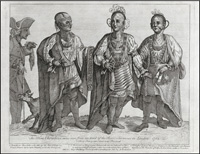The Native American Population of British America

When the English began to colonize the east coast of North America, they encountered over 100,000 Indians living there. Europeans brought horses and guns, which were unknown in the Indians' world. In addition, they also brought diseases for which Indians lacked immunity. The results were disastrous. By the 1760s, the Indians' total population from New England to Georgia stood at slightly more than 30,000. Even though British settlements had not expanded over the Appalachian Mountains by 1750, British material goods had. Their presence spawned competition among the Indians living there. This warfare and the impact of European diseases hit hard among Indians living in the Gulf region as well as it did to those living north of the Ohio River. In the 1680s the population of such Indians as the Creek, Cherokee, and Choctaw stood at over 100,000. By 1760, their numbers may have fallen to as low as 42,000. In 1650, Indians living in the old Northwest, including such groups as the Erie, Miami, and Shawnee might have numbered somewhat over 20,000. By the mid-eighteenth century, that Indian population had fallen to about 6,000.
By 1750, many Indians living in the older British colonies, such as the Pamunkey in Virginia, lived on reservations. Or like the Delaware in Pennsylvania, they were moving west to the upper Ohio country. However, on the northeast frontier, the Abnaki, and in the southeast frontier, the Creek and Cherokee ranged freely. They and the Wyandot, Ottawa, and Miami of the Great Lakes region, for example, were caught tightly in a trade network dependent on British and French material goods. But so too were the many thousands of Indians who lived west of the Mississippi River. Especially there, access to European guns and horses shaped relationships. For example, with guns the Osage were able to control trade on the upper Arkansas and Red Rivers. Horses allowed the Comanche to raid south from the Great Plains into Oklahoma and north Texas. The more settled Pueblo Indians of the upper Rio Grande were also targets of the more mobile Apache.




